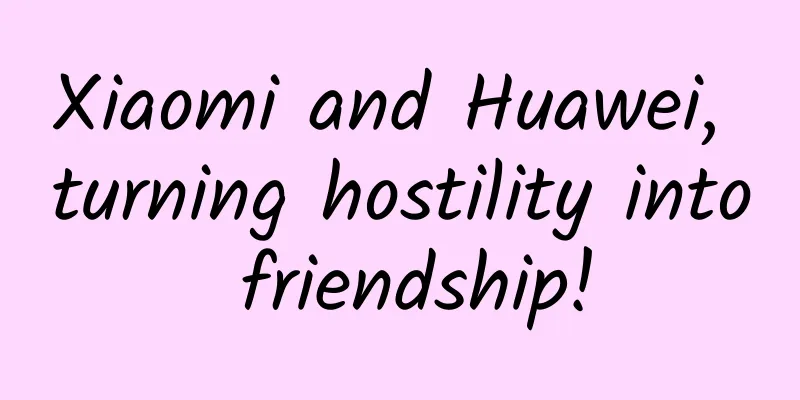Xiaomi and Huawei, turning hostility into friendship!

|
In recent days, the mobile phone industry has seen a climax of major manufacturers launching new products. The first was the launch of Huawei Mate60, whose self-developed Kirin 9000S chip instantly ignited the domestic mobile phone market and was recognized and praised by domestic and even foreign industry insiders. The invitation from Xiaomi founder Lei Jun to "join Huawei's technology ecosystem", which has been widely circulated online recently, has attracted great attention from netizens. Screenshot from Toutiao @刘哥抖料 As we all know, Xiaomi uses Qualcomm chips and Google operating systems. If the rumors are true, then Xiaomi is willing to give up both and turn to Huawei's technology platform, which is really surprising to the public. Are Xiaomi and Huawei really shaking hands and cooperating? 1. Shake hands and make peace, and take action earlyThere are signs that Xiaomi and Huawei are reaching a technological cooperation. I believe everyone still remembers that as early as January this year, Huawei and Xiaomi filed a patent infringement lawsuit, demanding that the infringement be stopped and compensation be paid, which attracted widespread attention in the industry. Xiaomi then filed an invalidation declaration for Huawei's related patents, and fell into a confrontation over patent disputes. However, both parties are experts in turning crises into opportunities. On September 13, Huawei and Xiaomi announced that they had reached a global patent cross-licensing agreement, finally bringing the dispute to an end. This event was seen by the industry as a "handshake and peace" between Huawei and Xiaomi. Behind this was the result of friendly communication between the two mobile phone giants. Fan Zhiyong, Director of Huawei's Intellectual Property Department, said: "Huawei is pleased to reach a license agreement with Xiaomi. This license agreement once again reflects the industry's recognition of Huawei's contribution to the field of communication standards, and also allows us to strengthen our research investment in future mobile communication technologies." At the same time, Xu Ran, general manager of Xiaomi Group's strategic cooperation department, said: "We are very pleased to reach a patent cross-licensing agreement with Huawei, which fully reflects the recognition and respect of each other's intellectual property rights. Xiaomi will continue to uphold Xiaomi's intellectual property values, respect intellectual property rights, seek win-win, long-term and sustainable intellectual property partnerships, and use intellectual property rights to promote technology inclusion and allow technology to benefit a wider range of people." 2. Huawei and Xiaomi need each other at this momentIndependent commentator Fu Liang expressed his views on the matter in an interview with China.com Finance, saying: "Nowadays, with the development of 5G technology and the continuous expansion of market demand, domestic mobile phone manufacturers such as Xiaomi will need to use relevant patents more frequently in the process of large-scale shipments, which is inseparable from Huawei's technology "supply"; and for Huawei, before the launch of new products such as Mate 60 this year, it was restricted by some factors and had been using 4G communication technology, which made it impossible to ship on a large scale, and the use of relevant patents was less than that of Xiaomi and other manufacturers." In fact, Huawei had a precedent for this type of cooperation as early as last year. In December 2022, Huawei announced that it had signed a global patent cross-licensing agreement with OPPO, which covers basic patents for cellular communication standards including 5G standards. Subsequently, Huawei also reached or renewed patent licensing agreements with Samsung and Nokia. In addition, in August this year, Huawei also signed a long-term global patent cross-licensing agreement with Ericsson. At this moment, Xiaomi needs Huawei, and Huawei also needs Xiaomi. In the collision of love and hate between Xiaomi and Huawei, Xiaomi and Huawei finally came to a new situation of mutual benefit and win-win. 3. Xiaomi needs to learn from Huawei to break throughMobile phones, IoT, and Internet services are Xiaomi's three major sources of revenue, with mobile phones being the most important. In the past few years, we have seen the layout and progress of Xiaomi's high-end mobile phone strategy, but due to the lack of chip and system advantages, it is destined to be difficult to reap the high-end profits. The overall shrinking market also makes it difficult for Xiaomi to continue its previous strategy of winning by "volume". In the second quarter, Xiaomi's mobile phone shipments fell 15.9% year-on-year to 32.9 million units. At the same time, Xiaomi's original globalization strategy is also facing a new wave of challenges. The pressure from Indian market policies is evident, and the overseas market shipments are also not optimistic. Xiaomi's global market share of 12.5% this quarter is also the lowest in the same period in the past three years. The global market is blocked and its own shortcomings such as chips are difficult to make up in a short time, which forced Xiaomi to rethink the "difficult but right thing to do". Of course, this is a long and thorny road. The sadness of Zheku's dissolution is still yesterday. Xiaomi naturally needs to explore a relatively stable long-term route. At present, it seems that Huawei's "technology supply" has become an assistant on this long-termism route. Huawei, the big brother in the industry, has accumulated considerable strength in technology patents. In the past decade, Huawei has invested nearly 1 trillion yuan in research and development. In the first half of 2023 alone, Huawei's R&D investment was 82.604 billion yuan, a year-on-year increase of 4.4%. It is reported that as of the end of last year, Huawei held more than 120,000 valid authorized patents worldwide, and it is in a leading position in many mainstream standard patent fields such as mobile communications, short-distance communications, and encoding and decoding. Xiaomi recently announced the official upgrade of its technology strategy and continued to increase its investment in research and development. In August this year, Lei Jun officially announced the upgrade of its technology strategy at the Xiaomi new product launch conference and announced Xiaomi's technology concept - to choose technology fields that have long-term value to human civilization and insist on long-term and continuous investment. 4. Is it feasible for Xiaomi to turn to Huawei technology?Of course, from a technical perspective, any domestic mobile phone manufacturer can adapt Hongmeng to its own operating system. This is because the foundation of Hongmeng operating system has been donated by Huawei to the Open Source Atomic Energy Foundation free of charge. In addition, Qualcomm has also achieved compatibility with Hongmeng operating system, and Qualcomm processors are not resistant to Hongmeng operating system. However, whether ecosystems can be compatible with each other depends more on commercial considerations. For Xiaomi's ecosystem, is it really feasible to make the existing ecosystem compatible with Hongmeng? For Huawei, is the production capacity of the popular Kirin chip really sufficient to be shared with other manufacturers? These are unlikely in the short term. But then again, if Xiaomi adapts to the Hongmeng system and can also use Huawei's chips, the benefits will be obvious: the bottleneck problem that has always existed will be solved. 5. In the end: Two-way choice in the stock eraWhen the external environment becomes uncertain, only by working together can we see the light at the end of the tunnel. Entering the stock era, every domestic mobile phone manufacturer is looking for a way out. Undoubtedly, continued investment in technology has become the "difficult but correct thing" to consolidate its own foundation, and the handshake and cooperation among various companies to achieve a mutually beneficial and win-win strategy is also an inevitable breakthrough. Huawei's technological strength is obvious to all. Obviously, for Xiaomi, if it successfully obtains Huawei's self-developed Kirin chips and Hongmeng operating system, it will bring them huge competitive advantages and revolutionary changes. For Huawei, cooperating with Xiaomi to further expand its technology ecosystem will also accelerate its establishment of a strong ecosystem and enhance its market share and brand advantages. In any case, we have seen the determination of both companies to achieve domestic technological independence. |
<<: Five-minute technical talk | A brief analysis of Android 14 updates and upgrades
Recommend
Why do early products need seed users?
When it comes to the concept of seed users , I be...
What does "starting with an egg" mean? This is called native advertising!
When doing information flow advertising , the mos...
Master these 4 points! Tik Tok search traffic is easily captured!
Do a little survey! If you were born after 85s, 9...
A growth experiment that increased product conversion rate by 30%
The steps for conducting growth experiments are g...
Smart hardware development is no longer mysterious - a software engineer's guide to smart hardware product development
[[128224]] Do you want to start a hardware bu...
Creative formulas and ideas for advertising in the medical beauty industry!
Sponsors have started a war to grab market share,...
Why do you try so hard to keep up with the latest trends?
Chasing hot topics is something that operators of...
[Exclusive for lazy people] Universal RecylerAdapter, built-in XRecyclerView, compatible with pull-up and pull-down and animation, high reuse, universal for all pages, support empty pages
Hello everyone, Guo Laoshi is here again. I used ...
Five major performance issues in 2014 apps and their solutions
The boom of mobile Internet has given rise to the...
Apple has gone too far: iOS forces you to use Apple Pay
If you are an iPhone user, you may have discovere...
Social APP Traffic Monetization Guide
Introduction: Due to the existence of "hate,...
Bilibili’s 2020 marketing plan!
Bilibili (English name: bilibili, referred to as ...
A qualified operator should have such an original intention!
First of all, this article comes from the sharing...
Why would the live streaming room for selling goods be blocked? What's the violation?
“Why can’t the product be put on the shelves?” “W...
Zhihu traffic generation methods and techniques!
When I wrote this title, my Zhihu community had j...









